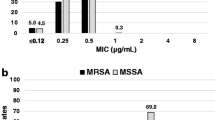Abstract
Methicillin-resistant Staphylococcus aureus (MRSA) infections treatment of which is hard and failed, due to being resistant to all types of β-lactams, have been emerged in hospitals and community. Long-term usage of antibiotics and over doses of antibiotics used in the treatment of infections cause bacteria to develop resistance to antibiotics. β-lactams combined with tannic acid can be a good alternative to sensitize the resistance of β-lactams used in the treatment of MRSA, due to their synergistic activities. In this study, after minimal inhibitory concentrations (MICs) and minimal bactericidal concentrations (MBCs) of sole tannic acid and β-lactam were investigated for each isolate, the synergistic activities of β-lactams combined with tannic acid against one MRSA ATCC 43300 and four MRSA clinical isolates were investigated with the concentrations starting at four fold of MICs of sole treatments of tannic acid and β-lactam by using checkerboard assay. To investigate sole and combination activities of tannic acid and β-lactams, MIC and MBCs were observed. Results of this study showed that the activities of β-lactams combined with tannic acid were synergistic and partially synergistic against MRSA isolates with FIC indexes ranged from 0.174 to 0.477 and 0.562 to 0.850, respectively. MIC of β-lactams were decreased 2–16 fold by sub-inhibitory concentrations of tannic acid without toxicity. Alternative treatment options of natural compounds such as tannic acid and β-lactams must be investigated further and developed to overcome the emergence of β-lactam resistance and treat MRSA infections by sensitizing the resistance of β-lactams.



Similar content being viewed by others
References
Andremont A, Bonten M, Kluytmans J, Carmeli Y, Cars O, Harbarth S (2011) Fighting bacterial resistance at the root: need for adapted EMEA guidelines. Lancet Infect Dis 11(1):6–8. https://doi.org/10.1016/S1473-3099(10)70227-9
Basri DF, Zin NM, Bakar NS, Rahmat F, Mohtar M (2008) Synergistic effects of phytochemicals and oxacillin on laboratory passage-derived vancomycin-intermediate Staphylococcus aureus strain. Am J Med Sci 8(131):6
Basri DF, Abdullah NA, Khairon R, Ishak SF, Zin NM (2015) Antagonistic effect of tannin on oxacillin efficacy against methicillin-resistant Staphylococcus aureus (MRSA) by time-kill assay. Middle East J Sci Res 23(10):2470–2478. https://doi.org/10.5829/idosi.mejsr.2015.23.10.10167
Bush LM (2011) Best alternative to vancomycin for serious methicillin-resistant Staphylococcus aureus Infections: let’s just say it. Clin Infect Dis 53(9):965–966
CLSI (2013) Performance standards for antimicrobial susceptibility testing; twenty-third informational supplement. Wayne PA: Clinical and Laboratory Standards Institute. CLSI document M100-S23
Dai J, Mumper RJ (2010) Plant phenolics: extraction, analysis and their antioxidant and anticancer properties. Molecules 15:7313–7352. https://doi.org/10.3390/molecules15107313
Diniz-Silva HT, da Silva Cirino IC, dos Santos Falcão-Silva V, Magnani M, de Souza EL, Siqueira-Júnior JP (2016) Tannic acid as a potential modulator of norfloxacin resistance in Staphylococcus aureus overexpressing norA. Chemotherapy 61(6):319–322. https://doi.org/10.1159/000443495
Federman C, Joo J, Almario JA, Salaheen S, Biswas D (2016) Citrus-derived oil inhibits Staphylococcus aureus growth and alters its interactions with bovine mammary cells. J Dairy Sci 99:3667–3674. https://doi.org/10.3168/jds.2015-10538
Hatano T, Tsugawa M, Ohyabu T, Kusuda M, Shiota S, Tsuchiya T, Yoshida T (2006) Effects of polyphenols in tea and foods on methicillin-resistant Staphylococcus aureus and the sustainability of the antibacterial effects in the presence of food additives. J Jpn Soc Med Use Funct Foods 4:43–48
Kirmusaoglu S, Yurdugul S, Vehid S (2017) Investigatıon of methicillin resistant Staphylococcus aureus nasal carriage and the effect of hand hygiene in the carriage. PONTE 73(4):276–283. https://doi.org/10.21506/j.ponte.2017.4.23
Kırmusaoğlu S (2017) MRSA and MSSA: the mechanism of methicillin resistance and the influence of methicillin resistance on biofilm phenotype of Staphylococcus aureus. In: Enany S, Alexander LE (eds), The rise of virulence and antibiotic resistance in Staphylococcus aureus. Intech, Croatia, pp 25–41. https://doi.org/10.5772/65452
Livermore DM (2000) Antibiotic resistance in staphylococci. Int J Antimicrob Agents 16:S3–S10
Moody J (2004) Susceptibility tests to evaluate synergism. In: Isenberg HD (ed) Clinical microbiology procedures handbook. ASM Press, Washington
NCCLS (1999) Methods for determining bactericidal activity of antimicrobial agent; approved guideline. Wayne PA, NCCLS. NCCLS document M26-A. ISBN 1-56238-384-1
Saginur R, Denis MS, Ferris W, Aaron SD, Chan F, Lee C, Ramotar K (2006) Multiple combination bactericidal testing of staphylococcal biofilms from ımplant-associated ınfections. Antimicrob Agents Chemother 50:55–61
Sanhueza L, Melo R, Montero R, Maisey K, Mendoza L, Wilkens M (2017) Synergistic interactions between phenolic compounds identified in grape pomace extract with antibiotics of different classes against Staphylococcus aureus and Escherichia coli. PLoS ONE 12(2):e0172273. https://doi.org/10.1371/journal.pone.0172273
Seeram NP, Adams LS, Henning SM, Niu Y, Zhang Y, Nair MG, Heber D (2005) In vitro antiproliferative, apoptotic and antioxidant activities of punicalagin, ellagic acid and a total pomegranate tannin extract are enhanced in combination with other polyphenols as found in pomegranate juice. J Nutr Biochem 16(6):360–367
Shibata H, Nakano T, Parvez A, Furukawa Y, Tomoishi A, Niim S, Higuti T (2009) Triple combinations of lower and longer alkyl gallates and oxacillin ımprove antibiotic synergy against methicillin-resistant Staphylococcus aureus. Antimicrob Agents Chemother 53(5):2218–2220. https://doi.org/10.1128/AAC.00829-08
Taguri T, Tanaka T, Kouno I (2004) Antimicrobial activity of 10 different plant polyphenols against bacteria causing food-borne disease. Biol Pharm Bull 27(12):1965–1969. https://doi.org/10.1248/bpb.27.1965
Weigel LM, Clewell DB, Gill SR, Clark NC, McDougal LK, Flannagan SE, Tenover FC (2003) Genetic analysis of a high-level vancomycin-resistant isolate of Staphylococcus aureus. Science 302(5650):1569–1571
Xie Y, Yang W, Tang F, Chen X, Ren L (2015) Antibacterial activities of flavonoids: structure-activity relationship. Curr Med Chem 22:132–149
Acknowledgements
I would like to thank Assist.Prof. Ayyub Ebrahimi, his students MSc. Özge Barım and MSc. Gizem Sümer, and my MSc. student Havva Kaşıkçı for kindly support in the study of cell viability assay.
Author information
Authors and Affiliations
Corresponding author
Additional information
Publisher’s Note
Springer Nature remains neutral with regard to jurisdictional claims in published maps and institutional affiliations.
Rights and permissions
About this article
Cite this article
Kırmusaoğlu, S. Sensitizing of β-lactam resistance by tannic acid in methicillin-resistant S. aureus. World J Microbiol Biotechnol 35, 57 (2019). https://doi.org/10.1007/s11274-019-2637-6
Received:
Accepted:
Published:
DOI: https://doi.org/10.1007/s11274-019-2637-6




